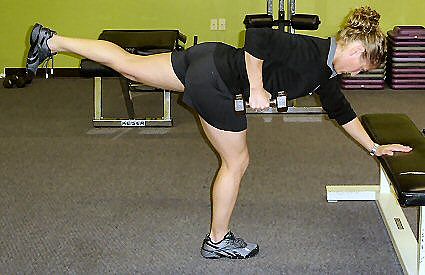Six Big Myths About Strength Training
Myth No. 1: Strength training will make you bulky.
Weight training is a great way to add muscle mass; but it also doesn't have to add mass.
Core and functional strength training balances movement and muscle groups, and helps prevent injury. The more functional (directly transferable to movement) lean mass you have, the leaner and more toned you are, and the more energy you burn while at rest.
The body core is key to these movements. This includes the muscle groups in your abdomen, back, glutes and hips -- or the muscles that directly support posture of the body "pillar." Professional athletic training facility Athlete's Performance (based in Arizona) bases all strength training around the core.
If you do add a little mass during initial strength-building phases, you will lean out later as you lighten loads and develop functional power. Also, remember that worked muscles retain more water as the tissue repairs itself, leading to a temporarily bulkier appearance. An ice bath will minimize this problem!
Some examples of "functional" exercises that involve your core and challenge multiple muscle groups at once: standing, 1-leg dumbbell row, split squat curl to press, alternate-arm dumbbell chest press on a swiss ball.

Myth No. 2: Flexibility has no effect on strength.
"The more pliable the muscle, the more ability it has to produce work,” explains Ann Frederick, co-author of Stretch to Win. “And by stretching the surrounding connective tissue, you’re able to have larger, more defined muscles, not just stronger ones. This is because tightness in the facial tissue restricts how much a muscle can grow.”
The amount of mass you actually build depends on the amount of weight you lift; so if you want to stay lean, light, and toned, focus on core and functional strength, increasing load only in certain phases. If you want to increase muscle size, focus on building maximum strength with shorter sets and heavier weights. (As always, I can help you design the perfect strength program for you!)
If you train for bulk, this means -- bigger muscles, faster! If you train for leanness, it means better muscle tone, sooner.

Myth No 3: You burn more fat in longer, low-weight or low-intensity workouts.
With frequent, long or very intense exercise, the body learns to use energy (including any stored fat) more efficiently. Endurance athletes actually burn fewer calories at the same pace, the fitter they are.
Short, intense intervals can burn as many calories as a long workout. (Always work up gradually to high-intensity exercise, to prevent muscle strain or serious cardiovascular problems!) Including heavy-weight and "power" phases in your strength routine will rev up the metabolism more than doing high reps all the time.
The best way to reduce body fat is to replace fat with muscle, through strength training and refueling with adequate protein and complex carbohydrates.

Myth No. 4: Doing high reps with light weights is the best way to tone your arms and legs.
Lots of reps with light weights allow your muscles, joints and connective tissue (fascia) to adapt to moving against resistance. It's important to start with a short adaptive phase (at least 3-4 weeks) before increasing loads, especially if you haven't done weight training for more than a few weeks prior.
However, in order for muscles to grow and appear "toned," they must be challenged. This can be through heavier weights, or with faster lift tempo, or both. An ideal scenario is a phased weight-training approach, where you adapt the muscles, then build maximum strength, then drop the loads and work on power, or a fast-tempo lift with slow recovery.
You Have to Work Hard to Build Muscle!
Myth No. 5: There's no place for heavy weight training in endurance sports.
It's true that during race season for running, cycling, swimming, triathlon, adventure racing, etc., you'd get bogged down by heavy lifting. However, during off-season or early season while building base endurance and strength is the ideal time to increase loads.
Building an early base of extreme strength in the movements you use most in your sport pays big dividends later. For example, doing early-season squats at your 6-rep maximum load will allow you to develop incredible power on the bike once that fatigue drains from your legs.

Myth No. 6: You should never stretch during a strength workout, only afterwards.
Stretching during a strength workout is a great way to counter-balance the tightening and shortening of muscles caused by weight training. This helps you develop strong and long muscles.
But, do not hold stretches for more than five seconds each during a strength workout -- this actually fatigues the muscle and inhibit further use. Sustained stretching is best after a workout, when the muscles are still warm, but you're cooling down.
Functional, or dynamic, stretching is a fluid series of movements. It's based on the principle that to get ready to use a muscle, you must activate the muscle, and you do it by using the same range of motion as the real work you're about to do. Functional stretching activates and warms up muscles and muscle connectors (such as tendons), without fatiguing the muscles.

Functional stretching involves holding a stretch for about two seconds, and repeating that movement 3-5 times. For example, between two sets of a row exercise, you would stretch the lats (latissimus dorsi) in this manner.
Important: Start any functional or dynamic stretching movement gently. Do the move slowly first, to get the feel for how far you can comfortably stretch. You should feel a stretch, but no pain!
Functional stretching is also a perfect warmup for any workout. Because it gets the muscles firing in a pattern that supports the movement you're going to do, it shortens warm-up time, increases potential power once you're in motion, and reduces the risk of pulling or injuring soft tissue.








